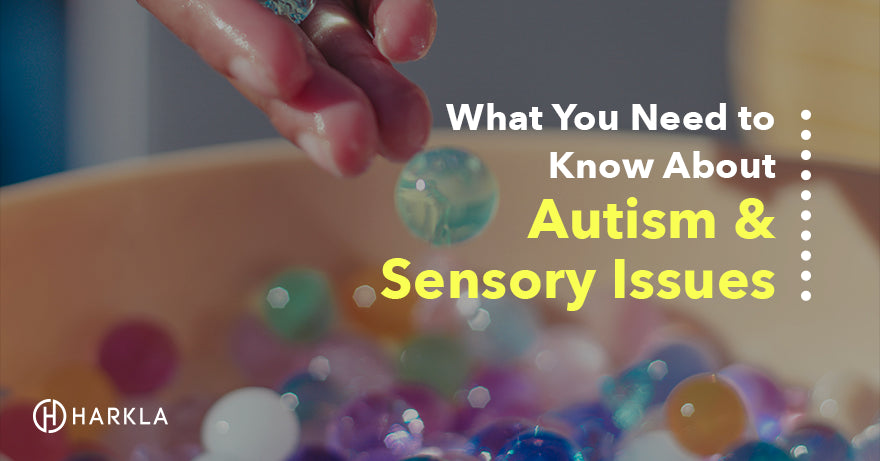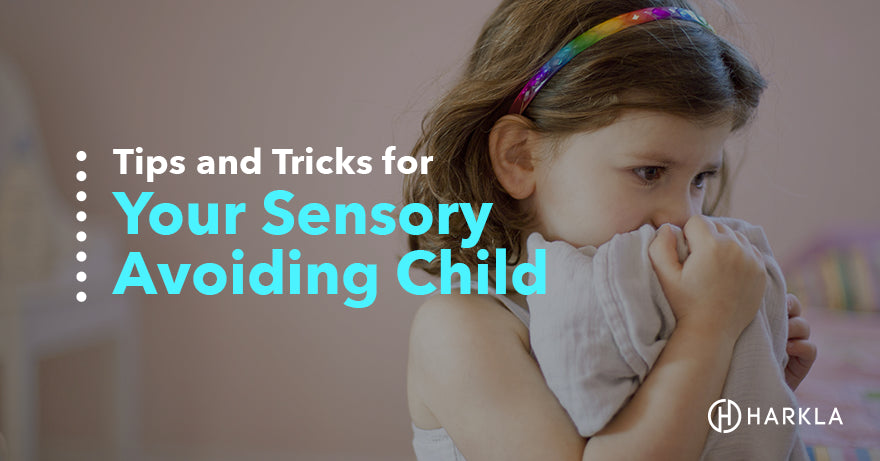Your Cart is Empty

In 2014, the U.S. Centers for Disease Control reported that 1 in 68 school-aged children were diagnosed with Autism Spectrum Disorder. A more recent parent survey conducted by the National Center for Health Statistics puts that number much higher, reporting 1 in 40 children aged 3 and older have autism.
When we look at the frequency of this diagnosis, it’s important to look past the statistics and realize that, with every new diagnosis of a child, there is a family desperately trying to decipher what this new label means, how it will impact daily life, and what they can do to help their child develop, learn, interact, and be successful.
One of these labels that we will be discussing in this article is sensory processing disorder, and how autism and sensory issues can be related.
First, let's start with a quick look at autism spectrum disorder.
Luckily, there are many professional organizations that aim to educate parents on Autism Spectrum Disorder. Autism Speaks provides parents with the most recently revised diagnostic criteria for Autism Spectrum Disorder as published by the Diagnostic and Statistical Manual of Mental Disorders (DSM-5).
Here is an outline of the criteria:
The reason it is important to read all of these criteria in one view is to better understand some of the “symptoms” or “behaviors” of autism, how some of these symptoms can be connected to sensory issues in autism, and how to help your child make “sense” of it all!
If you’re new to a diagnosis of autism, you may just be starting to learn some other medical jargon like sensory integration, sensory processing, and sensory processing disorder. In the therapy world, and especially when there is a diagnosis of autism, these terms are often spoken about without recognizing that the average person has no understanding of how complex our sensory systems actually are!
Did you know that there are actually 8 sensory systems in your body, not just 5?
Our bodies take information in through sensory systems:
Sensory Integration is the process your central nervous system goes through when it takes information in from your body’s 8 senses, processes that information, and then responds accordingly.
When one’s central nervous system has difficulty processing any of this sensory information, the body’s responses are atypical and can be observed in motor, language, or behavioral skill difficulties.
Occupational therapists diagnose these atypicalities as Sensory Processing Disorder or SPD.
When we talk about Sensory Processing Dysfunction (SPD), occupational therapists diagnose 3 subtypes of SPD: sensory modulation disorder, sensory-based motor disorder, and sensory discrimination disorder.
Each subtype is characterized by different deficit areas that will advise treatment for your child.
For more information on the differences between these three types of SPD, check out our article on it here.
For more information about sensory integration therapy, check out Harkla’s article here.
The STAR institute estimates, based on their research, that 75% of children with autism have “significant symptoms of sensory processing disorder.” But do sensory issues mean autism? Given that high correlation and comorbidity rate, we need to talk about how sensory processing disorder manifests in people with autism and how to support sensory processing to help them make sense of it all.
For people with autism, sensory processing dysfunction can manifest in many different ways, such as:
In addition to developmental signs, autistic people may also show everyday behaviors that signal sensory challenges. These are often some of the first signs of autism sensory problems that parents, teachers, or caregivers notice in daily life. Examples include:
Covering ears or eyes to block overwhelming input
Refusing or insisting on certain foods or clothing items
Chewing on non-food objects or needing to fidget constantly
Frequent touching of others or playing in a rough way
Rocking, hand flapping, or repeating noises to self-regulate
Shutting down or going quiet when overstimulated
Experiencing meltdowns when sensory input becomes overwhelming
Difficulty noticing internal signals like hunger, pain, or needing the bathroom
Now consider how many of those symptoms of sensory processing were also mentioned in the diagnostic criteria of the DSM-5. It’s no wonder that a multi-sensory approach to programming for children with autism is effective!
Sensory integration therapy can minimize some of these symptoms of autism by improving sensory processing skills.
For a child or adult with autism, sensory challenges aren’t just “quirks” - they can feel overwhelming and exhausting. Everyday situations that most people barely notice may take a huge amount of effort to handle.
For example:
Bright lights (like fluorescent or LED bulbs) may feel harsh or painful.
Background noises, buzzing, or sudden sounds can make it nearly impossible to focus on a conversation.
Certain textures in clothing or food may feel unbearable and cause avoidance.
Over time, coping with these sensitivities can leave a person drained - both physically and emotionally. Many autistic people use stimming (like rocking, hand-flapping, or fidgeting) as a way to calm themselves or block out uncomfortable input.
When sensory input builds up faster than the person can cope, it can lead to sensory overload. This might look like anxiety, a strong need to leave the situation, difficulty speaking, or even a shutdown/meltdown.
Making small changes to the environment can help children and adults with autism feel more comfortable, reduce stress, and better manage daily life. The right accommodations depend on whether a person is hypersensitive (over-responsive) or hyposensitive (under-responsive) to sensory input.
Accommodations for Hypersensitivity (too much input):
Use sunglasses, hats, or light filters in bright spaces
Wear headphones or earplugs in noisy environments
Create quiet spaces at home or school for breaks
Avoid strong perfumes, cleaners, or scented products
Choose soft, tag-free, or seamless clothing
Adjust routines to avoid crowded or busy times
Accommodations for Hyposensitivity (seeking more input):
Provide fidget toys, chew tools, or textured objects
Use weighted blankets, lap pads, or clothing with deep pressure
Allow frequent movement breaks during school or work
Rearrange spaces to allow safe climbing, jumping, or spinning
Offer foods with strong flavors, textures, or temperatures
Use visual supports or cues for those who miss internal signals like hunger or pain
With the right support, sensory challenges don’t have to hold someone back. These accommodations make it easier for autistic people to learn, socialize, and participate in everyday activities while feeling safe and understood.
If you’ve read any of Harkla’s blog articles on Autism and Sensory Processing, you probably have a solid basic understanding of the language occupational therapists frequently speak!
Fortunately, supporting sensory needs for those with autism is the exact same as for those who only have sensory processing disorder. You can read more about our tips and guides to sensory processing disorder here.
You’ll read about:
Let us at Harkla know how else we can support you, your child with autism, and how to address these sensory issues!
Resources
A Sensory Integration Therapy Program on Sensory Problems for Children with Autism." (n.d.): n. pag. Perceptual and Motor Skills. Web. 08 June 2017.
Case-Smith, Jane, and Teresa Bryan. "The Effects of Occupational Therapy With Sensory Integration Emphasis on Preschool-Age Children With Autism." (n.d.): n. pag. American Journal of Occupational Therapy. American Occupational Therapy Association, 01 Sept. 1999. Web. 08 June 2017.
"DSM-5 Diagnostic Criteria." Autism Speaks. N.p., 28 July 2013. Web. 08 June 2017.
Pfeiffer, Beth A., Kristie Koenig, Moya Kinnealey, Megan Sheppard, and Lorrie Henderson. "Effectiveness of Sensory Integration Interventions in Children With Autism Spectrum Disorders: A Pilot Study." (n.d.): n. pag. American Journal of Occupational Therapy. American Occupational Therapy Association, 01 Jan. 2011. Web. 08 June 2017.
"Sensory Processing in Children with Autism Spectrum Disorders and Impact on Functioning." (n.d.): n. pag. Sensory Processing in Children with Autism Spectrum Disorders and Impact on Functioning - ScienceDirect. Web. 08 June 2017.
Comments will be approved before showing up.


Jasmine Poole
February 03, 2021
Thank you for this information!!! My son has a communication device and I feel like he’s not benefiting from it as much as he should because he likes hearing the words he presses versus using it to tell what he wants. He’s a super sensory kid. How do I combat this? (We work with an SLP…but what should I be expecting from the SLP in aiding in this—especially with Covid restricting much direct interaction?)